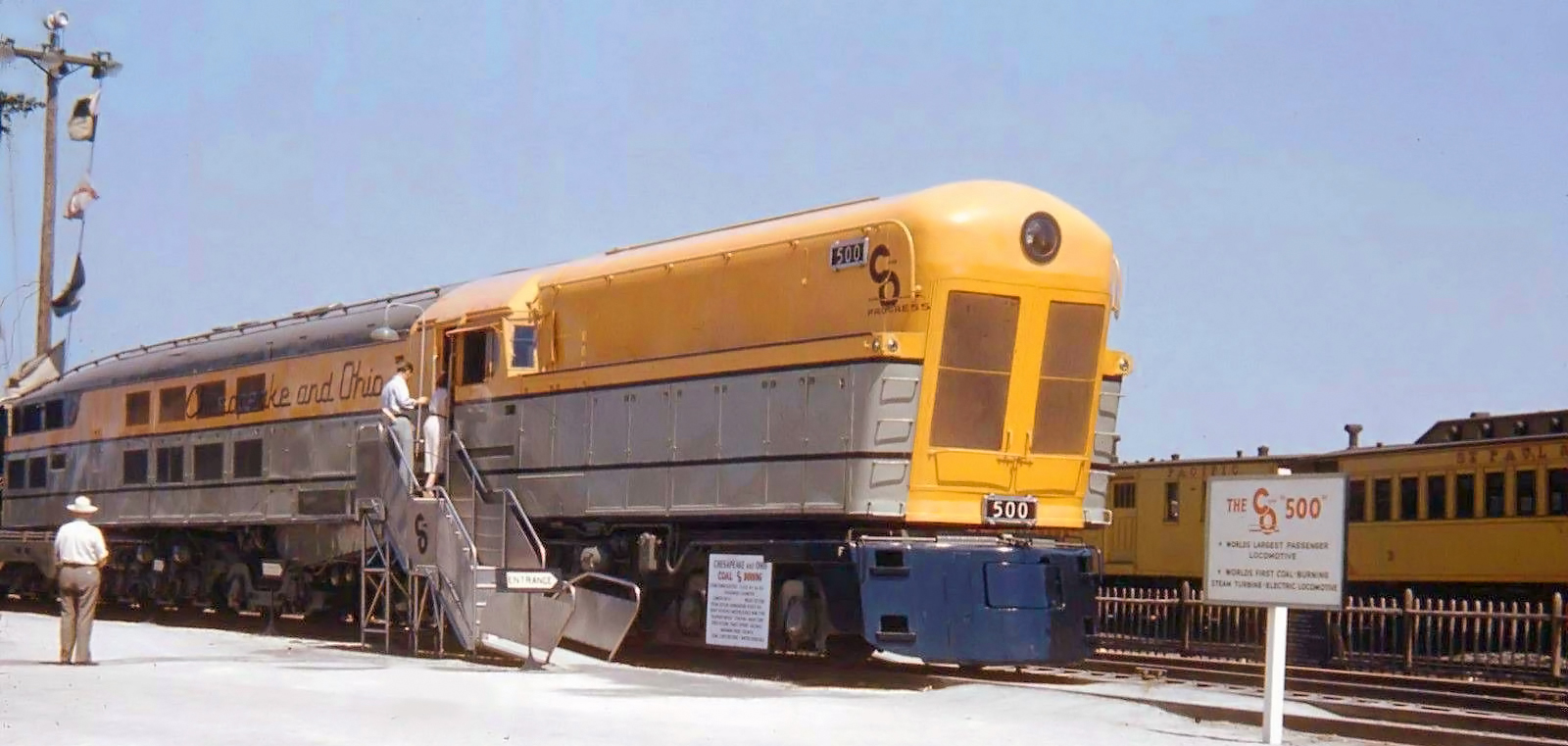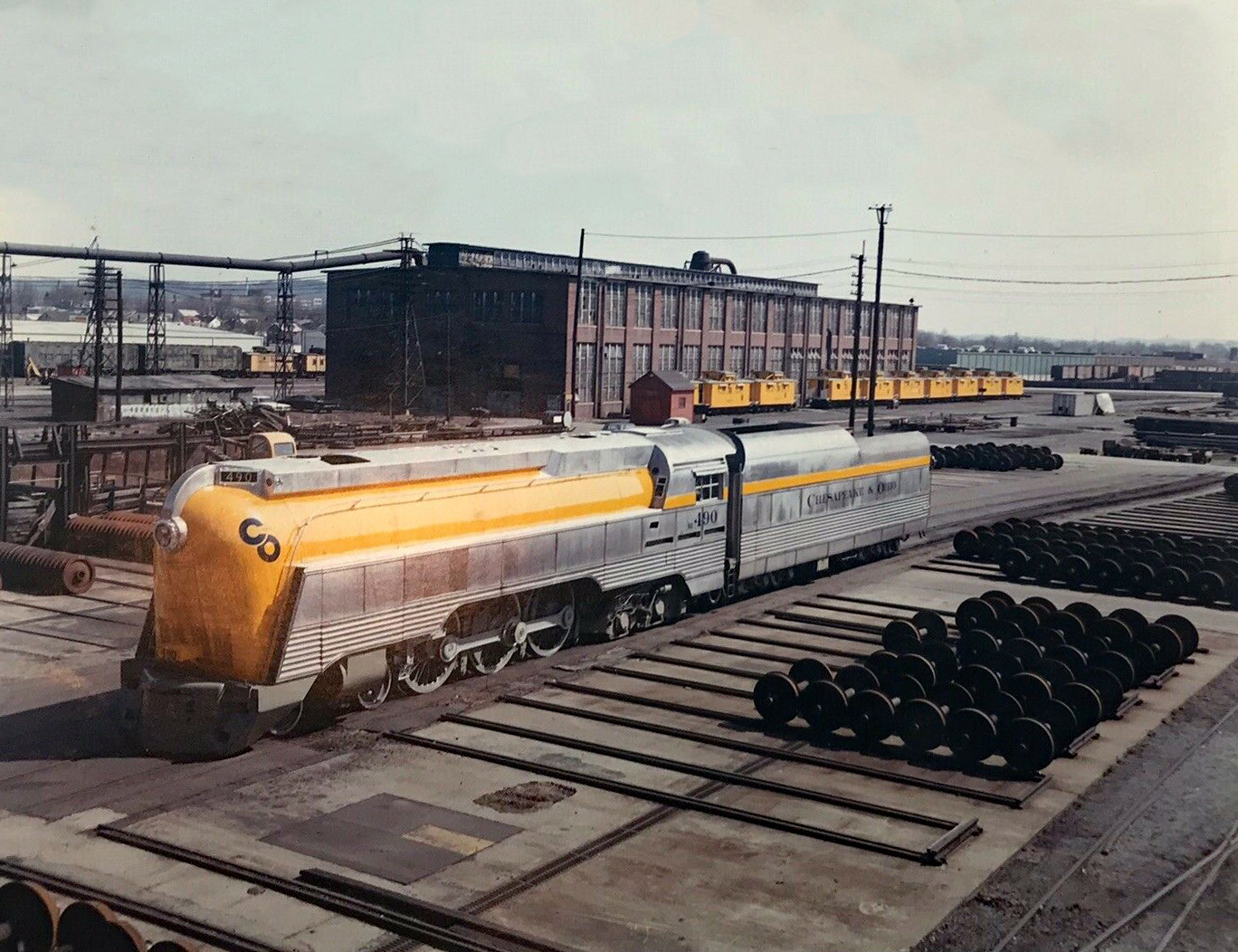C&O's "The Chessie" (Streamliner): History, Consist, Photos
Last revised: February 27, 2025
By: Adam Burns
The Chesapeake & Ohio did not spend lavishly on its passenger trains until Robert Young became chairman in 1942. The Chessie was one his concepts,
He fervently believed the service was an important and integral part of a railroad's business. In addition, through offering high quality customer service and exquisite accommodations Young felt these trains could remain profitable in the postwar era.
This belief led to the creation of "The Chessie," an all-new, all-coach service between Washington, D.C. and Cincinnati, Ohio. The train was also envisioned to be entirely steam powered using a new type of technology, steam turbines.
C&O officials believed coal could be harnessed efficiently in such a locomotive and effectively compete against the newfangled diesel-electric. The railroad also had another incentive to invest in steam turbines, a cheap and steady source of fuel, coal.
Young wanted to launch The Chessie directly after World War II. However, Pullman was backlogged with orders. The equipment ultimately did not arrive until the early 1950s at which point sagging ridership - and mechanical issues with the steam turbine - convinced even Young to abandon the concept.
Photos
 Chesapeake & Ohio M-1 steam turbine #500 on display at the Chicago Railroad Fair in 1948. The railroad was quite proud of its product, as noted by the sign, but alas it never saw regular service.
Chesapeake & Ohio M-1 steam turbine #500 on display at the Chicago Railroad Fair in 1948. The railroad was quite proud of its product, as noted by the sign, but alas it never saw regular service.Robert Young
While the C&O had historically focused primarily on its freight business, particularly coal, it did field a small fleet of fine trains including the George Washington, Sportsman, and Fast Flying Virginian (F.F.V.). When Robert Young became president in 1942 everything changed.
He believed strongly in this business with intentions of seriously upgrading the railroad's passenger department after World War II. Believing the C&O should take full advantage of the robust travel business he quickly placed orders for new equipment from the Budd Company and Pullman-Standard.
However, the backlog for streamlined cars at the time delayed the new equipment's arrival for more than two years; a situation which would eventually doom the Chessie.
Development
An early 1944 order from Budd had arrived by the summer of 1946 allowing the C&O to launch its new regional streamliner, the Pere Marquette, between Detroit and Grand Rapids, Michigan that August.
The trains operated via subsidiary Pere Marquette Railway and very successful, further cementing Young's belief in postwar passenger service.
According to Thomas Dixon, Jr.'s, "Chesapeake & Ohio Passenger Service: 1847-1971," the C&O boasted the Chessie as the most luxurious all-coach train ever launched.
The name carried deep roots within the company's culture as "Chessie, The Sleeping Kitten" had became a marketing sensation when the little fur feline debuted in 1933. The iconic mascot became the unofficial symbol of the C&O throughout its corporate existence, which led to the railroad's nickname as "Chessie."
M-1 Steam Turbine
In addition to the C&O's bold statement of luxury, the train was also powered by new technology, a steam-turbine locomotive designed by General Electric and Baldwin, dubbed the Class M-1.
The railroad intended to utilize these massive locomotives in handling The Chessie for the duration of its trip with fueling stops at Clifton Forge, Virginia and Hinton, West Virginia.
 In a photo that appears to have been taken just before its delivery to the Baltimore & Ohio Railroad Museum we see Chesapeake & Ohio 4-6-4 #490 (L-1) at the railroad's Huntington, West Virginia engine shops, circa 1968.
In a photo that appears to have been taken just before its delivery to the Baltimore & Ohio Railroad Museum we see Chesapeake & Ohio 4-6-4 #490 (L-1) at the railroad's Huntington, West Virginia engine shops, circa 1968.Unfortunately, while steam-turbines were powerful and fast on paper they were an unproven design. The three streamlined M-1's built, #500-502, carried a 2-C1+2-C1-B wheel arrangement and ultimately never got the chance to prove themselves in service due to their poor performance during testing.
The locomotives were completed between 1947 and 1948; after only a few years on the road the turbines were scrapped in 1950.
Streamlined Cars
In 1946 the Chesapeake & Ohio placed a 48-car order from Budd for its new Chessie (which included domes, lounges, diners, and coaches) followed by a massive 287 car order on November 19th from Pullman-Standard to reequip its entire passenger fleet with all-new, lightweight equipment.
According to Mike Schafer and Joe Welsh's book, "Streamliners: History Of A Railroad Icon," the C&O's research department, headed by Ken Brown, was heavily involved in the development of these new cars. Instead of accepting designs that were more-or-less "off the shelf" the C&O went its own way.
Some of its more notable improvements included moving bedrooms to the center of sleepers where the ride was smoother, partitioning coaches to provide a more open feel for passengers during their trip, providing twin-unit diners, baby changing rooms, a theater for kids, and even goldfish aquariums!
Aside from the Chessie's radical car designs Young was ahead of his time with customer service offering a type of early credit card system, passenger representatives available on every train, hostesses, pay-on-train ticketing, the C&O's Central Reservation Bureau that enabled travelers to call toll-free and book a trip, and the discontinuance of tipping porters and waiters.
Such a considerable departure from traditional, conservative industry ideas was thanks to Young's non-railroading background, a man who hailed from broader business roots. Alas, even his visionary thinking could not save the C&O's passenger business although he continued efforts to curb the losses until moving on the New York Central chairmanship in 1954.
Setbacks and Cancellation
With the Chessie's new equipment delayed until mid-1948, and the rest even later, it was clear Young's hope of launching the train directly after the war would not transpire.
Along with continually sagging patronage the Chessie was quietly shelved that same year. The cars were transferred in October to the Pere Marquettes and subsequently sold a few years later.
The large, 287-car order was partially delivered with the C&O taking on 151 by the spring of 1950 while the rest on order had been picked up by other railroads; 33 of the cars eventually delivered were quickly sold as well with the rest used to reequip the remaining heavyweight coaches and Pullman sleepers then still in service.
Sources
- Dixon, Thomas W. Chesapeake And Ohio Railway: A Concise History And Fact Book. Clifton Forge: Chesapeake & Ohio Historical Society, 2012.
- Dixon, Thomas W. Chesapeake & Ohio Passenger Service: 1847-1971. Clifton Forge: Chesapeake & Ohio Historical Society, 2013.
- Schafer, Mike and Welsh, Joe. Streamliners, History of a Railroad Icon. St. Paul: MBI Publishing, 2003.
Recent Articles
-
Nevada's - Murder Mystery - Dinner Train Rides
Jan 07, 26 02:12 PM
Seamlessly blending the romance of train travel with the allure of a theatrical whodunit, these excursions promise suspense, delight, and an unforgettable journey through Nevada’s heart. -
West Virginia's - Murder Mystery - Dinner Train Rides
Jan 07, 26 02:08 PM
For those looking to combine the allure of a train ride with an engaging whodunit, the murder mystery dinner trains offer a uniquely thrilling experience. -
Kansas's - Murder Mystery - Dinner Train Rides
Jan 07, 26 01:53 PM
Kansas, known for its sprawling wheat fields and rich history, hides a unique gem that promises both intrigue and culinary delight—murder mystery dinner trains. -
Michigan's - Wine Tasting - Train Rides
Jan 07, 26 12:36 PM
In this article, we’ll delve into the world of Michigan’s wine tasting train experiences that cater to both wine connoisseurs and railway aficionados. -
Indiana's - Wine Tasting - Train Rides
Jan 07, 26 12:33 PM
In this article, we'll delve into the experience of wine tasting trains in Indiana, exploring their routes, services, and the rising popularity of this unique adventure. -
South Dakota's - Wine Tasting - Train Rides
Jan 07, 26 12:30 PM
For wine enthusiasts and adventurers alike, South Dakota introduces a novel way to experience its local viticulture: wine tasting aboard the Black Hills Central Railroad. -
Kentucky Thomas The Train Rides
Jan 07, 26 12:26 PM
If you’ve got a Thomas fan in the house, Day Out With Thomas at the Kentucky Railway Museum is one of those “circle it on the calendar” weekends. -
Michigan's Thomas The Train Rides
Jan 07, 26 12:10 PM
If you’ve got a Thomas fan in the house, few spring outings feel as “storybook-real” as Day Out With Thomas™ at Greenfield Village in Dearborn, Michigan. -
Texas Dinner Train Rides On The TSR!
Jan 07, 26 11:36 AM
Today, TSR markets itself as a round-trip, four-hour, 25-mile journey between Palestine and Rusk—an easy day trip (or date-night centerpiece) with just the right amount of history baked in. -
Iowa Dinner Train Rides In Boone!
Jan 07, 26 11:06 AM
If you’ve ever wished you could pair a leisurely rail journey with a proper sit-down meal—white tablecloths, big windows, and countryside rolling by—the Boone & Scenic Valley Railroad & Museum in Boon… -
Wisconsin Dinner Train Rides In North Freedom!
Jan 06, 26 10:18 PM
Featured here is a practical guide to Mid-Continent’s dining train concept—what the experience is like, the kinds of menus the museum has offered, and what to expect when you book. -
Pennsylvania Dinner Train Rides In Boyertown!
Jan 06, 26 06:48 PM
With beautifully restored vintage equipment, carefully curated menus, and theatrical storytelling woven into each trip, the Colebrookdale Railroad offers far more than a simple meal on rails. -
North Carolina ~ Murder Mystery ~ Dinner Train Ride
Jan 06, 26 11:26 AM
While there are currently no murder mystery dinner trains in the Tarheel State the Burgaw Depot does host a murder mystery dinner experience in September! -
Florida's - Murder Mystery - Dinner Train Rides
Jan 06, 26 11:23 AM
Florida, known for its vibrant culture, dazzling beaches, and thrilling theme parks, also offers a unique blend of mystery and fine dining aboard its murder mystery dinner trains. -
New Mexico's - Wine Tasting - Train Rides
Jan 06, 26 11:19 AM
For oenophiles and adventure seekers alike, wine tasting train rides in New Mexico provide a unique opportunity to explore the region's vineyards in comfort and style. -
Ohio's - Wine Tasting - Train Rides
Jan 06, 26 11:14 AM
Among the intriguing ways to experience Ohio's splendor is aboard the wine tasting trains that journey through some of Ohio's most picturesque vineyards and wineries. -
Connecticut's Thomas The Train Rides
Jan 06, 26 11:06 AM
For 2026, the tour stop at Essex brings Thomas (and Percy, too) to the historic Valley Railroad for a full day of events for the kids. -
Maryland's Thomas The Train Rides
Jan 06, 26 11:00 AM
In 2026, the B&O Railroad Museum in Baltimore welcomes the Let’s Rock, Let’s Roll Tour with four event days that combine a Thomas-themed excursion with other activities. -
Tennessee's Thomas The Train Rides
Jan 06, 26 10:51 AM
Set on the grounds of one of the Southeast’s best-known operating railroad museums, the Thomas the train event blends kid-friendly fun with the unmistakable sights, sounds, and atmosphere of a real wo… -
Georgia's Thomas The Train Rides
Jan 06, 26 10:44 AM
Day Out With Thomas is set to roll back into Cordele in 2026, bringing Thomas the Tank Engine and a full family festival to the SAM Shortline at Georgia Veterans Memorial State Park.





















